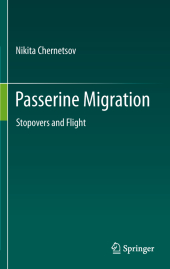 Neuerscheinungen 2014Stand: 2020-02-01 |
Schnellsuche
ISBN/Stichwort/Autor
|
Herderstraße 10
10625 Berlin
Tel.: 030 315 714 16
Fax 030 315 714 14
info@buchspektrum.de |

Nikita Chernetsov
Passerine Migration
Stopovers and Flight
2012. 2014. xii, 184 S. 29 SW-Abb.,. 235 mm
Verlag/Jahr: SPRINGER, BERLIN; KMK SCIENTIFIC PRESS LTD, MOSCOW 2014
ISBN: 3-642-43328-6 (3642433286)
Neue ISBN: 978-3-642-43328-3 (9783642433283)
Preis und Lieferzeit: Bitte klicken
Most birds cannot cover the distance between their breeding and winter quarters in one hop. They have to make multiple flights alternated with stopovers. Which factors govern the birds´ decisions to stop, to stop for how long, when to resume flight? What is better - to accumulate much fuel and to make long flights for many hundreds of kilometres, or to travel in small steps? Is it necessary to find habitats similar to the breeding ones or other habitats would do? Are long migratory flights indeed so costly energetically as usually assumed? This monograph summarizes our current knowledge on the ecology of songbird migrants during migratory stopovers and on their behaviour._
Foreword.- Introduction.- 1. Stopover duration, 1.1. Methods of estimating stopover duration, 1.2. Estimates based on re-encounters of marked birds, 1.3. Estimates based on radio-tagging, 1.4. Within-species variance in stopover duration: ´transients´ and ´non-transients´, 1.5. Concluding remarks.- 2. Fuel deposition rate and energy efficiency of stopovers, 2.1. Energy stores of migrants, 2.2. Methods of estimating fuel deposition rate, 2 .3. Empirical FDR values, 2.4. Factors that influence FDR, 2.5. Low initial FDR: an artefact or real phenomenon?.- 3. Optimal migration theory, 3.1. General remarks, 3.2. Time minimisation, 3.3. Minimisation of energy cost of migration, 3.4. Predation risk minimisation, 3.5. Basic equations, 3.6. Concluding remarks.- 4. Habitat selection and use by migrants, 4.1. Introductory remarks, 4.2. Scales of habitat selection at stopover, 4.3. Role of individual experience, 4.4. Termination of migratory flights, 4.5. Search for home range and settling, 4.6. Habitat exploitation,4.7. Fuel deposition in oases, 4.8. Fuel deposition on islands.- 5. Spatial behaviour at stopovers, 5.1. Introductory remarks, 5.2. Range and direction of daytime movements of nocturnal migrants, 5.3. Restricted home ranges vs. broad movements:visual observations and recapture analysis, 5.4. Spatial behaviour at stopovers: radio-tracking data, 5.5. Impact of fuel stores on spatial behaviour, 5.6. Spatial behaviour of songbird migrants at stopover and spatial distribution of food.- 6. Temporal pattern and energy cost of migratory flight, 6.1. Time of nocturnal migratory departures, 6.2. Body mass and fuel stores at nocturnal migratory departure, 6.3. Nocturnal departures of lean birds and reverse migration at night, 6.4. Relationship between fuel stores and take-off time, 6.5. Time of ceasing flight, 6.6. Body mass at arrival after migratory flights, 6.7. Estimates of energy costs of migratory flight.- 7. Migratory flights and stopovers: organisation of migration, 7.1. Theoretically possible fuel deposition rate, 7.2. Factors that influence departure decisions, 7.3. Series of migratory flights and waves of passage, 7.4. Spring vs. autumn migration, 7.5. Migration of a typical long-distance passerine nocturnal migrant.- Conclusions.- References _


